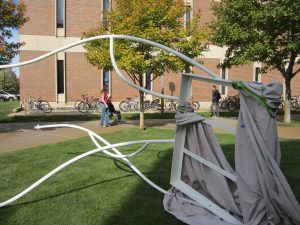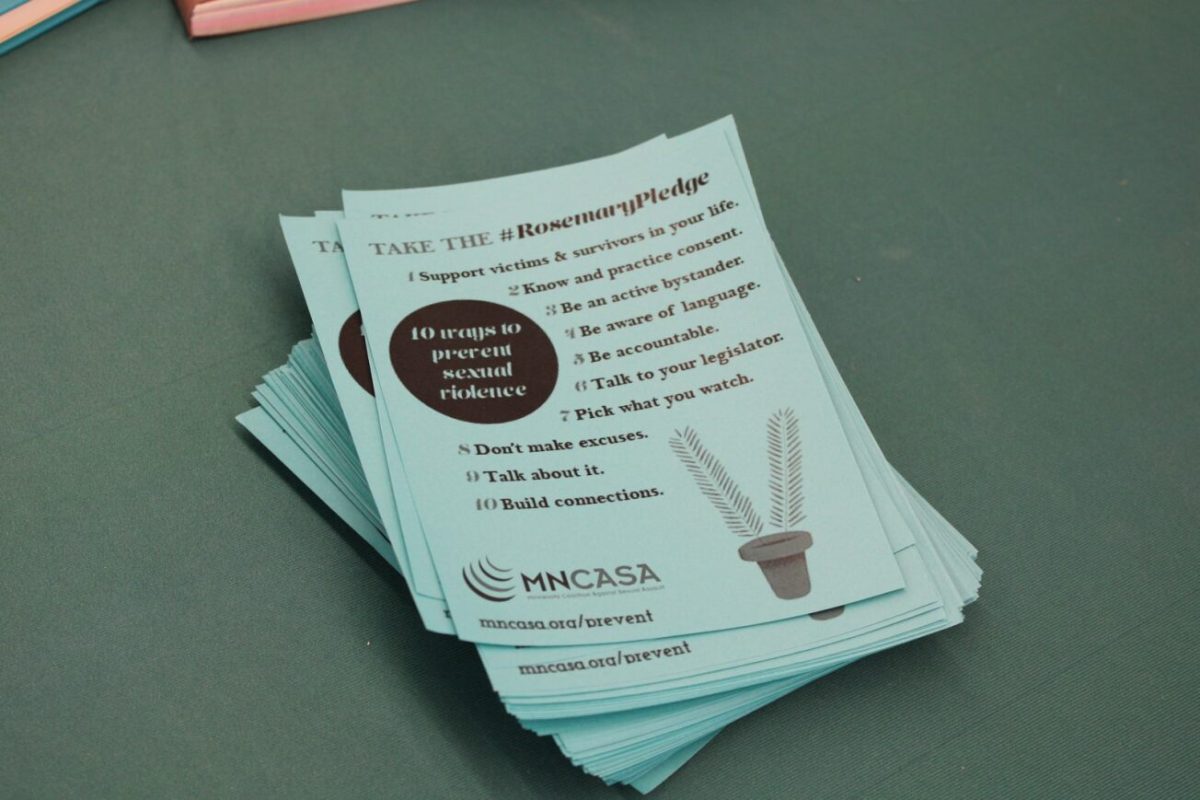
MARCIA RATLIFF
Marcia Ratliff/Winonan
What may look like an extraterrestrial landing device abandoned between Minne and the library is actually the frame for an interactive eco-sculpture.
Chemistry professor Jeanne Franz and physics professor Frederick Otto got a grant from the Minnesota Pollution Control Agency to do an alternative energy project using solar panels three years ago.
Originally, the idea was to create a solar charging station for laptops on campus.
But Franz and Otto wanted their project to do more than charge laptops. They wanted it to be a landmark for sustainability.
So they asked Chun Lok Mah, a graphic design professor, to help them redesign the project. They decided they would create a sculpture that combined their disciplines and highlighted sustainability.
Once the project grew, Franz secured another grant from the WSU Foundation and a Higher Learning Commission Next Chapter grant.
A solar panel on top of the sculpture will give power to a device that measures ozone, an air pollutant, in the air on campus.
Franz said detecting lower-level ozone requires a measuring device with a high level of sensitivity—one that can cost over $10,000.
Franz said she did not want to stop there.
“I’m an analytical chemist,” she said. “I build things that can measure things.” She researched and found a way to make a device for a few hundred dollars, enlisting students to help.
Senior biochemistry and cell and molecular biology student Andrew Jacobson has been a part of the project since Franz brought it up in his analytical chemistry class. “I was pretty excited to know that we could use this device,” he said of the ozone measuring piece.
Jacobson said he and his classmates used data from the Minnesota Pollution Control Agency to calibrate their instruments for the device.
The ozone information will be constantly displayed on a solar-powered LED screen on the sculpture.
Otto spent his sabbatical year working on the electronics that will go within the sculpture. In addition, he has had three years’ worth of electronics students testing LEDs and designing circuitry.
When it’s finished, the sculpture will be self-sustaining. “There will be no wires of any kind connected to anything,” Otto said.
The sculpture has three thin, wavy legs that support a rectangular panel at the top, which will have the solar panel and LCD screen.
When it’s finished, the sculpture will be self-sustaining. “There will be no wires of any kind connected to anything,” Otto said.
The sculpture has three thin, wavy legs that support a rectangular panel at the top, which will have the solar panel and LCD screen.
The sculpture’s steel frame will be covered in sustainable, donated materials.
One leg, representing winter, will be covered with plastic spoons. “It’s a plastic utensil that we throw away all the time,” Mah said.
He said he figured it would be easy to collect thousands of spoons, serving as a demonstration of how much people waste.
Another leg, representing summer, will be covered in green fabric donated by community members. Copper wire will cover the final leg, to represent fall.
Once the sculpture is set up in its place between Minne and the library, students will put the spoons, wire, and fabric on the legs.
While the sculpture’s construction will be very labor-intensive, Mah said this fits with the goal of the sculpture. “The community can feel ownership, like they are part of the project,” he said.
Mah said the sculpture will deteriorate in the weather, on purpose, so that it looks like a ruin, a juxtaposition of technology and nature.
“If everything goes well, it will still look good,” Mah said.
In addition, Otto said the sculpture will adapt to the conditions around it, demonstrating the kind of intelligent energy management he hopes the sculpture inspires.
“If it’s dark, we’ll dim the light,” he said. “We wanted to make this interesting and fun and changeable, so you’re not quite sure what it’s going to do.”
Graphic design students Andrew Noble and Jose Dominguez have been involved with the project since last year, when Mah asked them if they were interested in designing for it.
Dominguez said this was a natural step for him after taking a design class from Mah. “Mah does a great job of making stuff as close to the real world as possible, for a good cause,” he said.
Together Dominguez and Noble designed the promotional materials for the project, most of which have been posted at businesses around Winona.
Noble said for him the appeal of the project was how it combined design and science. “When you think of design, you think of fashion or building a house. You never think of cleaning up the environment,” he said.
There are collection bins for spoons, wires, and fabric in the loading dock at Watkins Hall. Mah said so far wires have been the most challenging to collect.
The team hopes to have the sculpture finished by the end of the academic year.
Right now, the sculpture’s steel frame is complete and awaiting installation between Minne and the Darrell Krueger Library.
Mah said he hopes the area will be eventually made into an eco-farm of solar panels and sculptures surrounding his own.
Contact Marcia at MRatliff09@winona.edu






























